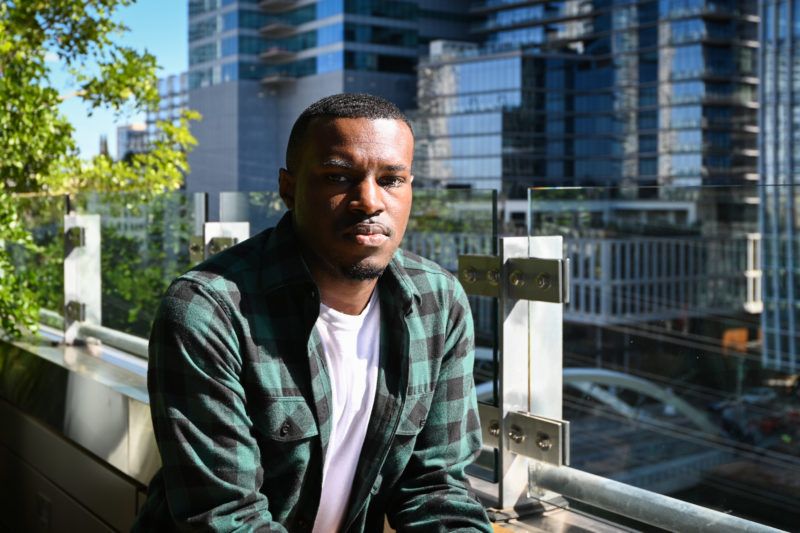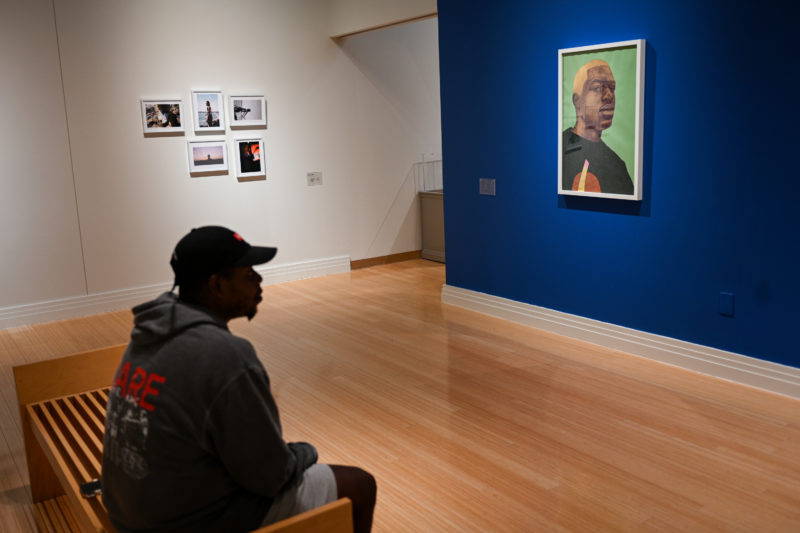NFTs are leveling the playing field for Black artists. Here’s why.
By Pamela Hall Vance
Reporting Texas

Artist Bryson Williams at the downtown Austin Public Library in Austin on Oct. 30, 2021. Pamela Hall Vance/Reporting Texas
Ask most people what NFT stands for, and you will likely draw a blank stare. To Austin artist and illustrator Bryson Williams, it spells opportunity.
“It’s a game changer as far as giving digital artists way more control over how much money they make on their work,” said Williams, who has worked on several NFT projects.
Anything that can be digitally represented — artwork, music, photographs, videos — can be an NFT, or non-fungible token. For example, a JPEG photo or GIF can be easily “minted” into an NFT for digital sale, and the record of NFT ownership and transaction history will be stored on the blockchain or official ledger shared by computers. Payment for NFTs is usually made in cryptocurrency.
This new digital marketplace came into the public eye in the past year. It is now opening doors for Black artists in Central Texas who might have struggled to sell their work in traditional galleries and navigate an art world with museum collections that have been reported to be more than 85% white.
“The problem with the art scene for many artists has been for the longest time it’s been a good old boys club,” said Patrick Jones, owner of the SoCo Modern Art Gallery in Austin. “It’s been the exclusive domain of the wealthy and the elite. NFTs give any artist access to the entire world of art collectors in an instant. That access alone takes away all barriers to entry, and the only limiting factor at that point is how good is your work.”
For artists like Williams, NFTs provide a new avenue to reach an audience.

Artist Bryson Williams shows a series of digital art NFTs, Hood Olympics, at the downtown Austin Public Library on Oct. 30, 2021. Pamela Hall Vance/Reporting Texas
Williams’ first NFT commission was an album cover for Shontelle Layne, a 35-year-old Barbadian Grammy-nominated singer/songwriter who has written for the artist Rihanna and released two albums.
“Her recording studio reached out to me,” Williams said. She was one of the first Black female artists to release NFTs with this project.
The top bidder paid $15,000 for the track and received customized House Party artwork, a dubplate with the fan’s name incorporated into the song, a music video cameo and a preview of unreleased music.
Williams also created digital art for the Campbell-Williams Field NFT Collection for the University of Texas. His Longhorn Legacies artwork commemorates Heisman Trophy winners Earl Campbell and Ricky Williams.
“I just saw it as a different way to make art,” said Adrian Armstrong, an Austin-based multimedia artist who wanted to explore the realm of NFT art.
His first opportunity came when a friend asked him to participate in a NFT exhibition in June 2021 in New York City. “Both NFTs sold as well as all three of the works,” said Armstrong. “I think I made 3.5 Ethereum on the purchase.” That is over $14,000.

Artist Adrian Armstrong contemplates artwork from the Small Black Museum Residency project on Oct. 30, 2021, at the Carver Museum in Austin. Pamela Hall Vance/Reporting Texas
Jeremiah Long, a journalist and director of product for Dallas Weekly, has been in the NFT space for quite a while and has sold three NFT collections. The newspaper minted its May 26, 2021, edition as an NFT.
“In the NFT world,” Long explained, “I could make a digital drawing, I could sell it to you specifically, and you could show that you are the digital owner of that piece art and … when you send me cryptocurrency in exchange for that piece of art, it goes directly from you to me, peer to peer. And I don’t have to go to a gallery; I don’t have to ask Instagram; I don’t have to ask anybody. It’s completely decentralized.”
Long says that independent artists are finally getting a chance to get their voices heard and that institutions looking to make that same thing happen are also getting social capital from it.
Yahoo has a new NFT initiative called “Black Art. Black Stories. Black Voices.” It will help eight artists enter the NFT marketplace. Visa is also supporting entrepreneurs in the “creator economy” by partnering with minority artist Micah Johnson to build a program designed to help creators understand NFT technology and how to harness public blockchains for producing and selling digital goods.
Iris Nevins, co-founder and CEO of Umba Daima Gallery in Atlanta, Georgia and the organization Black NFT Art, says that organizations like hers exist to help change lives by educating and helping Black artists. With their assistance, multiple artists have been able to quit their full-time jobs and make six-figure incomes in just the last few months, she said.
“It’s not an industry where you can just show up tomorrow and start making money right away,” Nevins said. “It’s a process. It’s a learning process. We don’t do the work for them, but we help to provide the resources and the network that can help them be successful.”
Other groups have sprung up to empower Black NFT creatives and collectors.
The first Black-owned NFT marketplace, called Disrupt Art, is focused on equity, diversity and NFT technology. Hip hop artist Waka Flocka has partnered with the 100% minority-owned Satoshi Art, an NFT platform for minority creatives. A Black Arts District has been created on the blockchain by the ONE/OFF initiative. HERSTORY is a decentralized autonomous organization that is working to make the NFT space more inclusive.
Ira Revels, an executive producer at Black Tech Futures Media in Connecticut, is helping educate Black people about NFT opportunities. Revels has featured NFT use cases on her podcast several times.
“I just want to spend all of my time making art and helping our people mint NFTs so they can begin to actually cultivate generational wealth,” Revels said.